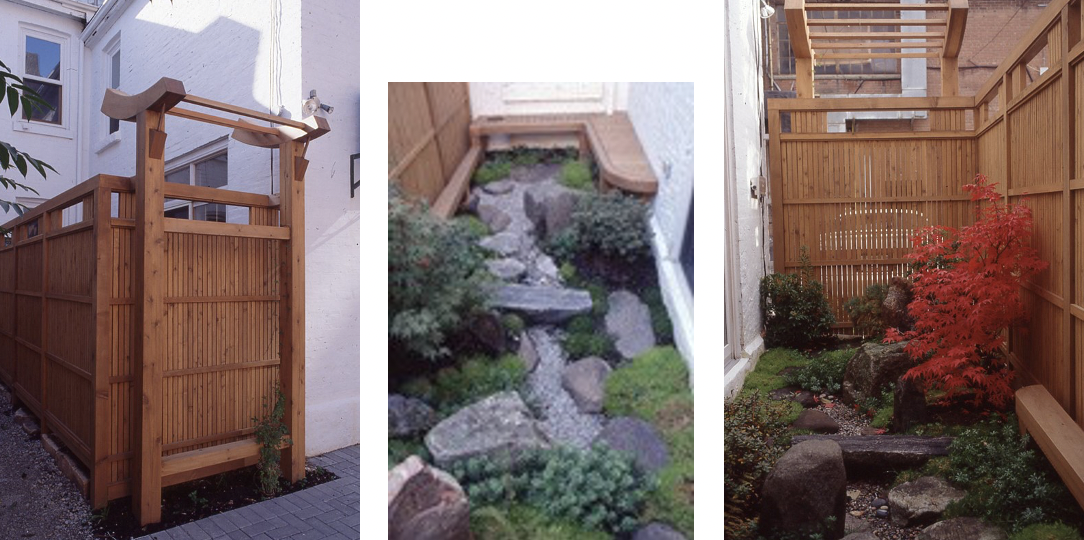Dennis Alan Winters
Tales of the Earth : Landscape Architecture, Toronto, Ontario, Canada gardens@talesoftheearth.com
A six-foot by seventeen-foot meditation garden occupies half an alcove of a downtown Toronto alley. The garden was built on clearly defined, mutually enhancing, qualitative and quantitative relationships. Investigating these relationships enhanced grounding for my work.
Tara Rinpoche, past Abbot of the Tibetan Buddhist Monastery in Bodh Gaya, India, once advised me to think of mediation as the art and practice of cultivating intimate familiarity.1 The relationships amplified in designing and building of this small garden pointed to objects of meditation — the presence, quality and nature of self and phenomena — by taking advantage of three opportunities.
- Harnessing the spiritual fuel that empowers the design of landscape. The most subtle faculty of mind that Buddhists identify as ‘Buddha-nature’ (Skt: Tatha-gatha-garbha), I call it the ‘Spark of Awakening’ — the individual’s source of wisdom and virtuous activities; of happiness, kindness and love; of the capacity to cry at the sight, sound and touch of beauty; and the source of the ability to produce beauty in artistic expression.2
- Attending to the client’s design vocabulary, to question what do unique expressions of Heaven on Earth, facsimile of Divine Form and Space, Buddha-fields, centre of cosmology, the weaving of Mind and Nature as one actually look like?3
- Creating a place of beauty in accord with Six Signs of Sacred Landscape: of Favourable Context, it is Contained, Coherent, Composed, Clarity, an aesthetic expression of Contemplation.4
I designed and built this landscape in 1992, exploring relationships between — person and garden; inside and outside; male and female; thrusting and absorbing; action and repose; offering and receiving; form and space; large and small; part and whole. I used design devices to modify and enhance the perceived small size of the garden — fence details that hid or revealed outside activities; diagonal orientation; relationship between ‘male’ and ‘female’ and mediator; layered elements. These aided to help deepen landscapes’ meaning to me. In turn, they helped give expression to who my client wanted to be.

Figures 1, 2, 3: Hy’s Garden, Photos by Dennis Winters
References
- Personal interview, Toronto, September 1990
- Dennis Winters. Searching for the Heart of Sacred Space (Toronto: The Sumeru Press, 2014): 133, 214.
- Posing this question, for example, see Gaston Bachelard. The Poetics of Space (Boston: Beacon Press,
1969) ; Thomas Berry. Evening Thoughts. (San Francisco: Sierra Club Books, 2006) ; Paul Brunton. The
Hidden Teaching Beyond Yoga. (New York: Samuel Weiser, 1977) ; Dionysius the Areopagite. The Divine
Names (Fintry, Surrey: The Shrine of Wisdom, 1957); Umberto Eco. The Aesthetics of Thomas Aquinas
(Cambridge: Harvard University Press, 1988); Yoshito Hakeda. Kukai – Major Works (New York: Columbia
University Press, 1972); B. Jowett. “Timaeus” in The Dialogues of Plato. (New York: Random House, 1937);
Geoffrey Keynes. Blake – Complete Works. (London: Oxford University Press, 1974); Plotinus. Stephen
MacKenna, trans. The Enneads (London: Penguin, 1991); Robert Thurman, trans. The Holy Teaching of
Vimalakirti (University Park: Pennsylvania State University, 2001); Stephen Whicher, ed. “Nature” in Selections from Ralph Waldo Emerson. (Boston: Houghton Mifflin Company, 1960)
4 See Dennis Winters. “Regarding Sacred Landscapes and the Everyday Corollary” in Thomas Barrie, Julio Bermudez and Phillip Tabb, ed. Architecture, Culture and Spirituality (Farnham: Ashgate, 2015): 149-163



